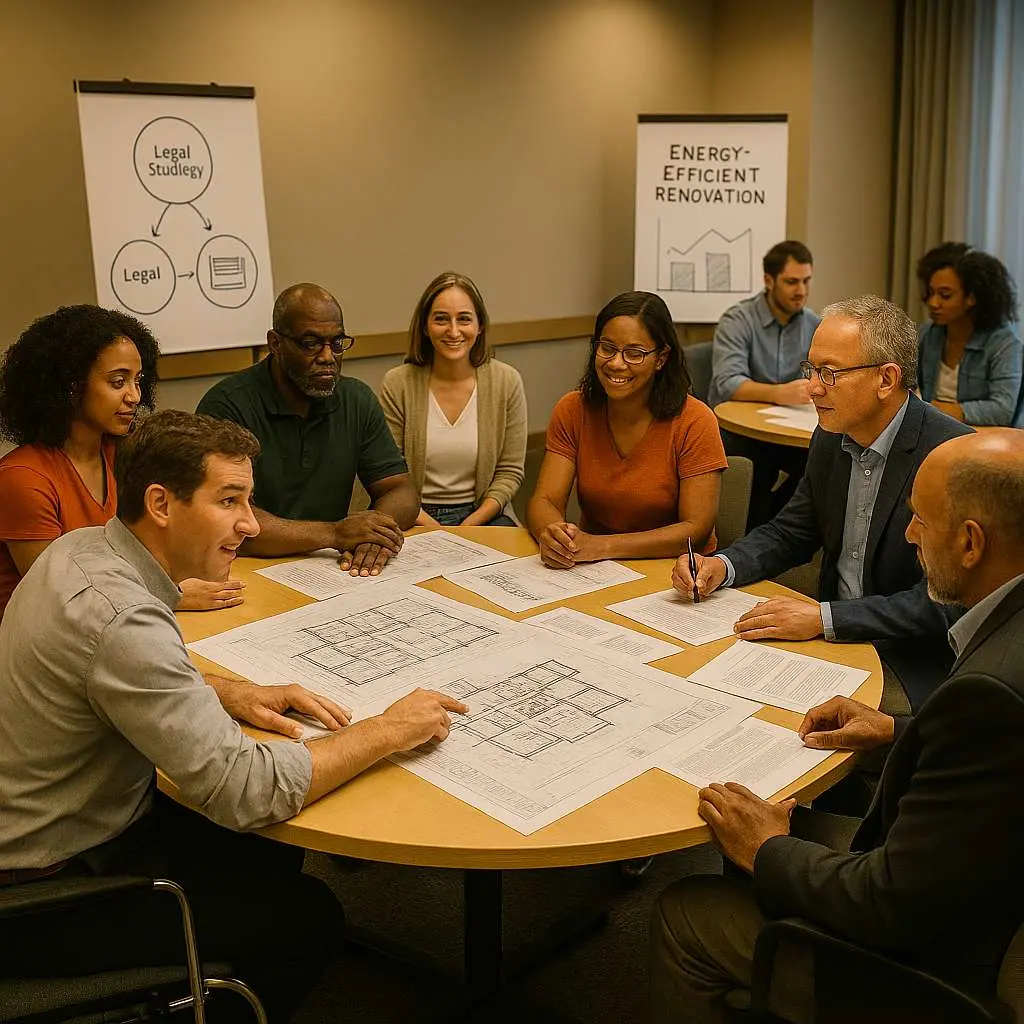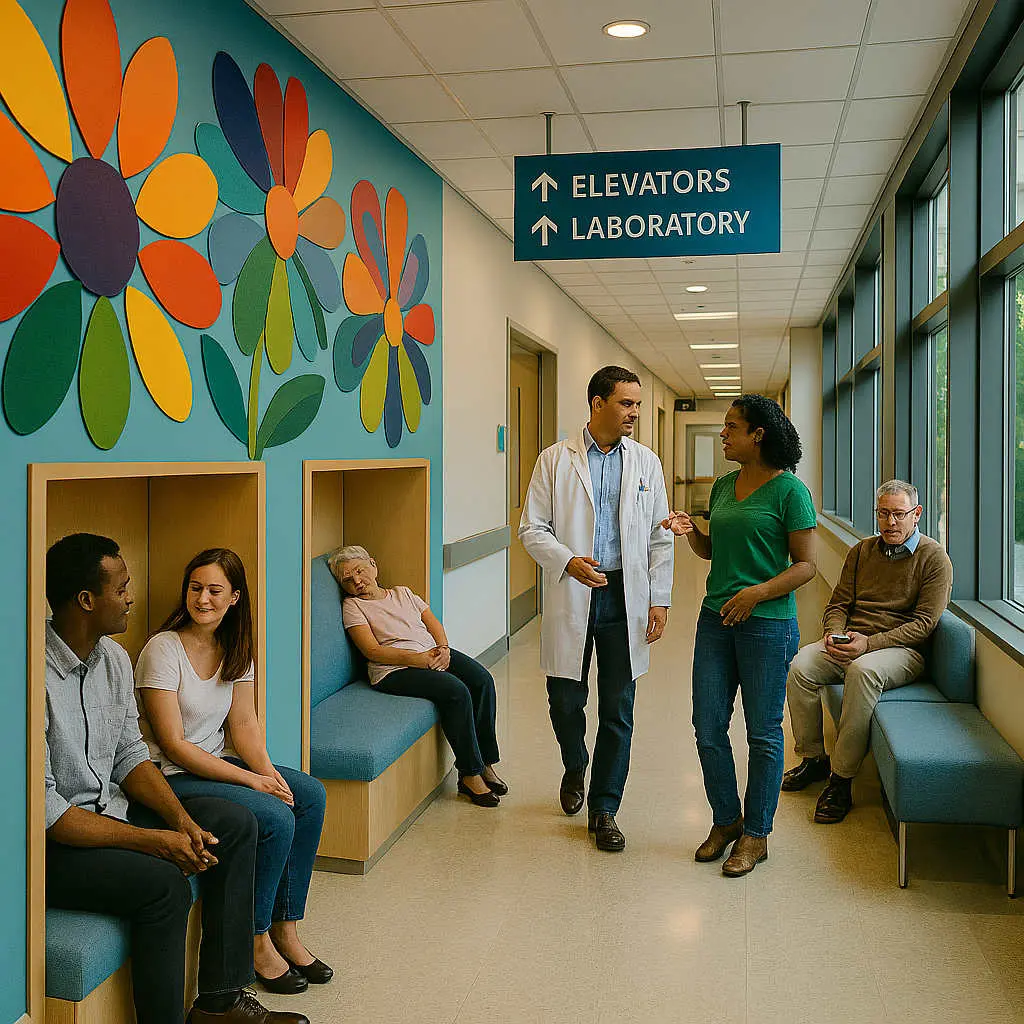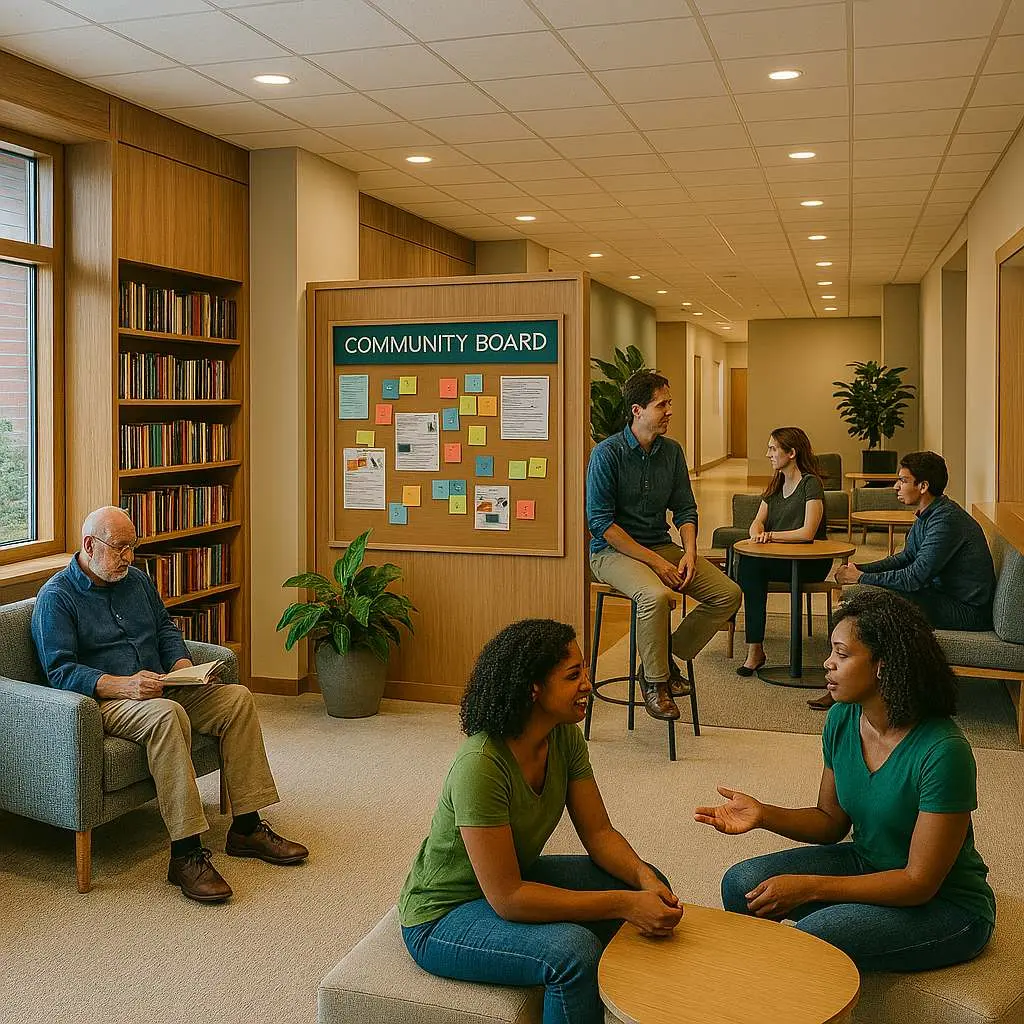My expertise in designing multi-user environments has taught me the value of balancing varied needs. At Curvspace, we create spaces that serve as intersections for diverse interests. This article reveals how multi-stakeholder design can transform transitional areas into dynamic hubs of engagement.
Jump to:
The Crossroads of Needs: Understanding the Intersection of Interests
Think about the spaces we inhabit daily. Rarely are they designed for a single person with a single purpose. From bustling office lobbies and university campuses to public plazas and healthcare facilities, most environments serve a multitude of people, each with their own agendas, expectations, and requirements. This convergence point is what I call the intersection of interests. It’s where the diverse needs, desires, and even conflicting priorities of various user groups—the stakeholders—meet within a shared physical environment.
Recognizing and designing for this intersection of interests isn’t just a ‘nice-to-have’; it’s becoming increasingly critical in our complex world. Populations are diversifying, work patterns are shifting, and the lines between public and private functions are blurring. Spaces must work harder, be more flexible, and cater to a wider range of activities and users than ever before. This is where multi-stakeholder design comes into play. It’s not merely about aesthetics or function in isolation; it’s a deep dive into understanding the ecosystem of users a space will serve and intentionally designing to support their interactions, both planned and serendipitous. Consider the difference between a sterile, single-purpose waiting room and a vibrant library lobby that also serves as a community notice board, a casual meeting spot, and a place for quiet contemplation. The latter embraces the intersection of interests, transforming a simple pass-through area into a dynamic hub. At Curvspace, we see these intersections not as challenges to be minimized, but as opportunities to create richer, more engaging collaborative spaces.
The Delicate Balance: Navigating the Challenges of Multi-Stakeholder Design
Let’s be honest: bringing multiple voices and needs into a single design process isn’t always straightforward. It’s often where the idealistic vision meets the messy reality of competing priorities, limited resources, and inherent power dynamics. I’ve sat in meetings where one group’s “must-have” directly contradicts another’s, or where budget constraints seem to pit essential functions against desirable enhancements. It can sometimes feel like a zero-sum game, where one stakeholder’s gain is another’s loss.
Early in my career, I worked on a community center project. We held initial meetings, gathered wish lists, and thought we had a clear direction. Yet, deep into the design phase, it became apparent that the underlying tensions between different community groups hadn’t truly surfaced in those early, polite conversations. One group prioritized large, open spaces for events, while another desperately needed smaller, quiet rooms for counseling services. The budget couldn’t easily accommodate both without significant compromise. I realized I’d asked what they wanted, but hadn’t dug deep enough into why. Understanding the “why”—the core problems they were trying to solve, the unspoken concerns, the internal team disagreements, or even external pressures—was crucial. That project was salvaged, but the stress was immense, and it taught me a vital lesson: superficial agreement isn’t true alignment.
The challenges are real:
- Diverse Decision-Makers: You’re often dealing with numerous groups – end-users, management, maintenance crews, funders, community representatives, regulatory bodies – each with their own lens.
- Competing Priorities: What’s critical for accessibility might clash with historical preservation guidelines. What enhances user experience might increase maintenance costs.
- Power Imbalances: Not all stakeholders have an equal voice or influence. Some groups might dominate discussions, while others hesitate to speak up, leading to designs that don’t truly serve everyone equitably.
- Resource Constraints: Budgets, timelines, and available space inevitably limit possibilities.
- Communication Gaps: Different groups use different jargon, have different assumptions, and may struggle to articulate their spatial needs effectively.
However, viewing these challenges solely as obstacles misses the potential. Andrew Lewis, AIA, points out that these varying viewpoints can be the “productive friction that drives more inventive outcomes“. The key is to move beyond simply collecting requirements and instead foster genuine dialogue, understanding, and collaboration from the outset. It requires sensitivity, strong interpersonal skills, and a structured approach to ensure all voices are heard and considered.
Laying the Foundation: Principles of Effective Multi-Stakeholder Design

Successfully navigating the intersection of interests requires more than just good intentions. It demands a structured, empathetic, and inclusive process. Over years of practice, I’ve found several core principles essential for turning potential conflict into creative collaboration.
Identifying and Engaging the Right Stakeholders
The very first step is figuring out who needs to be at the table. A stakeholder isn’t just the client paying the bills; it’s anyone with a vested interest in the space – positively or negatively affected by the design decisions. This definition is broad for a reason. Think about:
- Direct Users: Employees, residents, students, patients, visitors.
- Management & Operations: Facility managers, administrators, maintenance staff.
- Governance & Funding: Elected officials, regulatory bodies, donors, investors.
- Community Representatives: Neighborhood associations, advocacy groups, local businesses.
- Knowledge Institutions: Universities, research centers involved in related fields.
- Delivery Partners: NGOs, social enterprises providing services within the space.
Simply listing them isn’t enough. A shared mapping process helps visualize the stakeholder ecosystem. Tools like stakeholder analysis tables can clarify interests, motivations, and potential contributions. Distinguishing between ‘primary’ stakeholders (directly affected) and ‘secondary’ stakeholders (intermediary roles) is also useful. I often use a simple Importance/Influence Matrix to prioritize engagement efforts, focusing on those who have high interest and high influence, but also ensuring less influential but highly impacted groups aren’t overlooked.
Getting the right people involved at the right time is a skill in itself. Too early with too many details can overwhelm; too late means missing crucial input. But how do you get them engaged, especially those who are hard to reach or hesitant?
- Tailor Your Approach: Recognize that different stakeholders have different communication preferences and constraints. Jargon-free language and multiple channels are key. Elected officials might need concise briefings, while community groups might respond better to informal workshops.
- Address Barriers: Be proactive about understanding why someone might not participate. Is it lack of time? Childcare needs? Transportation issues? Feeling intimidated? Simple adjustments like meeting times and locations, providing translation, or offering small stipends can make a difference.
- Highlight the “What’s In It For Them”: Clearly articulate the benefits of participation – a better-designed space meeting their needs, improved local networks, influencing long-term vision, gaining new skills, or even potential funding opportunities.
- Set Clear Expectations: While emphasizing benefits, also clarify the expected commitment – regular attendance, active input. Giving members specific tasks or roles can increase ownership.
- Make it Easy: Produce clear, concise materials explaining the project goals and the value of their input.
I remember working on a library renovation where we specifically wanted input from teenagers, a notoriously hard-to-engage group. Standard evening meetings weren’t working. So, we went to them – setting up interactive feedback stations with colorful dot stickers and precedent images near the library’s young adult section during after-school hours. We used storyboarding to help them imagine “a day in the new library”. It took extra effort, but the insights we gained into their needs for charging stations, comfortable seating for groups, and quiet study zones were invaluable.
Building Relationships and Trust
Identifying stakeholders is just the start. Truly effective multi-stakeholder design hinges on building genuine relationships and fostering an environment of trust. This isn’t about manipulation; it’s about creating a “safe space” where people feel comfortable sharing honest opinions, challenging assumptions, and engaging in constructive dialogue, even when disagreements arise. As architects and designers, a critical part of our role extends beyond drawing plans; we become facilitators and relationship builders.
How do we cultivate this?
- The Physical (and Virtual) Setting Matters: Think carefully about the environment for interactions. Round tables avoid hierarchy. Comfortable furniture, good lighting, and minimal background noise help people relax and focus. For online meetings, using mute by default and ensuring good audio quality is essential. An open structure with space to move encourages informal conversation. Small group sizes (5-12 people) often facilitate better discussion than large forums.
- Set the Tone: Start meetings with welcoming remarks and perhaps an icebreaker or get-to-know-you exercise, especially for groups meeting for the first time. Using uplifting music upon arrival can create a positive atmosphere. The facilitator’s energy and attitude are infectious.
- Establish Ground Rules (Co-creation is best): Simple rules like “one conversation at a time,” “postpone judgment,” “build on others’ ideas,” and “focus on the issue, not the person” can significantly improve the quality of interaction. Emphasizing that ideas are co-created encourages collective ownership.
- Active Listening: This means truly hearing and acknowledging what’s being said, not just waiting for a chance to speak. Summarizing points and asking clarifying questions shows people they’ve been heard.
- Transparency: Be clear about the process, the constraints (like budget or regulations), and how decisions will be made. Managing expectations is vital.
I often think of the words attributed to Maya Angelou: “People will forget what you said, people will forget what you did, but people will never forget how you made them feel.” In stakeholder engagement, making people feel respected, heard, and valued is paramount for building the trust needed for difficult conversations and collaborative breakthroughs. This focus on relationship-building is central to approaches like Responsive Dialogues, which aim for sustainable change by fostering connections not just between the project team and stakeholders, but amongst the stakeholders themselves.
Designing for Inclusion and Equity
A truly successful multi-stakeholder space reflects and serves the diversity of its community. This means moving beyond token participation towards genuine inclusion and equity. It requires proactively identifying and addressing power imbalances that might otherwise skew the design process and outcomes.
Multi-stakeholder platforms (MSPs), when designed thoughtfully, aim to facilitate agreements that are more equitable and effective than top-down approaches. However, without care, they can also trivialize participation or reinforce existing inequities. So, how do we design for inclusion?
- Acknowledge Power Dynamics: Be aware of hierarchies – institutional, cultural, gender-based, etc. – and how they might influence participation. National experts might overshadow local community leaders, for instance.
- Implement Inclusive Processes: Use facilitation techniques that encourage broad participation. Breaking into small groups or pairs can help ensure everyone contributes, not just the most dominant voices. Briefly prepping potentially dominant stakeholders beforehand about the importance of hearing all perspectives can also be effective.
- Capacity Building: Sometimes, certain groups may need support to participate effectively. This could involve providing background information, technical assistance, or training.
- Procedural Rules: Clear rules about decision-making, speaking time, and conflict resolution can help level the playing field.
- Representation Matters: Ensure the group composition genuinely reflects the diversity of the user base and the wider community impacted by the project. Go the extra mile to include traditionally marginalized voices.
- Design With, Not For: This philosophy, highlighted by firms like Quinn Evans, emphasizes partnership. It’s about learning the community’s unique “dialect” and co-creating solutions rather than imposing preconceived ideas. Tools developed by organizations like CIFOR-ICRAF are specifically designed for platform participants themselves to use for reflection and monitoring, empowering them in the process.
Addressing equity isn’t just about who is in the room; it’s about whose needs are prioritized in the final design. It requires constant vigilance and asking critical questions: Whose perspective is missing? Who benefits most from this decision? Are we inadvertently creating barriers for certain groups?
Creative Challenge
Imagine you’re designing a public plaza. How could you design a feedback mechanism during the design process itself that intentionally amplifies the voices of children, the elderly, or people with disabilities – groups often less vocal in traditional public meetings? Could it involve playful installations, targeted workshops in accessible locations, or partnerships with advocacy groups? Thinking creatively about how we gather input is key to achieving genuine spatial unity that respects diverse needs.
Breathing Life into the In-Between: Transforming Transitional Spaces

We spend a surprising amount of time in transitional spaces: hallways, lobbies, waiting rooms, stairwells, corridors, the outdoor areas connecting buildings. Historically, these areas have often been treated as mere conduits – functional afterthoughts designed simply to get us from Point A to Point B. But what if we viewed them differently? At Curvspace, we see immense untapped potential in these “in-between” zones. Applying multi-stakeholder design principles here can transform them from sterile passages into vibrant, engaging collaborative spaces – the crucial intersection of interests where informal interactions, moments of pause, and community connections can flourish.
Why focus on transitional spaces?
- High Traffic, High Potential: Everyone passes through them, offering frequent opportunities for interaction or information exchange.
- Neutral Ground: They often lack the specific territoriality of dedicated offices or departments, potentially fostering broader connections.
- Setting the Tone: A welcoming, well-designed entryway or lobby shapes the first impression of an entire building or organization.
- Supporting Well-being: Thoughtful design in waiting areas can reduce stress; engaging corridors can encourage movement.
Consider a typical hospital corridor – often long, institutional, and devoid of character. Now imagine applying multi-stakeholder input. Patients might express a need for clearer wayfinding and places to rest. Families might want comfortable niches for private conversations or access to charging ports. Staff might need better lighting for safety and perhaps alcoves for quick consultations. Incorporating art curated by the local community could add warmth and identity. Suddenly, the corridor becomes more than just a pathway; it becomes a supportive element of the healing environment.
This transformation requires listening to the diverse needs of those who regularly use or pass through these spaces. What frustrates them? What would make their journey easier or more pleasant? What opportunities for connection are being missed?
Sensory design plays a huge role here. How can light be used not just for illumination but to guide, soothe, or energize? Can acoustics be managed to reduce stressful noise while allowing for quiet conversation? Could temperature variations create more comfortable zones for waiting or pausing? These elements, tuned through stakeholder feedback, contribute significantly to the quality of transitional spaces.
Think of these spaces as the connective tissue of a building or campus. Healthy connective tissue is flexible, supportive, and facilitates communication between different parts of the body. Similarly, well-designed transitional spaces, informed by multi-stakeholder design, weave together the different functions and user groups within an environment, fostering a sense of spatial unity and creating opportunities for those serendipitous encounters that spark new ideas and build community. How can we re-imagine the hallways in our schools, the lobbies in our offices, or the plazas in our cities not just as pathways, but as destinations in themselves?
The Toolkit for Co-Creation: Techniques and Tools for Collaboration
Bringing diverse stakeholders together effectively requires more than just scheduling meetings. It demands a versatile toolkit of techniques and methods designed to foster dialogue, generate ideas, build consensus, and translate needs into tangible design solutions. The goal is to create dynamic, interactive processes where participants feel engaged and empowered.
Workshops and Meetings: Beyond the Boardroom Table
Standard meetings with presentations and passive audiences rarely unlock the full potential of a multi-stakeholder group. Success lies in well-managed, interactive sessions with clear objectives and skilled facilitation.
- Structure and Format Variety: There’s no single right way. Consider:
- Group Structure: Will it be an open group where members can join anytime, or a closed, stable group for deeper relationship building? Perhaps topic-based sub-groups for focused work, or a core group supported by a wider network?
- Innovative Formats: Move beyond presentations. Try community planning events, hands-on planning with models, interactive displays where people can add ideas, site visits (“walkshops”), or even “vision fairs” where participants vote on preferred concepts.
- Engagement Techniques:
- Conversation over Presentation: Prioritize dialogue and hands-on activities.
- Active Roles: Allocate tasks and responsibilities during and between meetings. Consider rotating the chair role.
- Creative Play: Using tactile materials like Play-Doh, pipe cleaners, or building blocks can break down formalities, stimulate creativity, and encourage participation, especially across disciplinary or hierarchical barriers. It provides a fun, low-stakes way to explore complex issues and generate novel solutions, like the 3D models of risk communication tools created in workshops described by Cumiskey et al..
- Rapid Game Design (RGD): For tackling complex, interconnected issues (like resource management), co-creating simple games can be incredibly powerful. As seen in the Lower Kafue Basin project, stakeholders collaboratively designed games representing real-world challenges (e.g., balancing development and conservation, navigating competing water needs). This process fosters empathy, reveals trade-offs, and helps identify actionable solutions by translating between the “game world” and the “real world”.
Visual Communication: Making Ideas Tangible
Design itself is a powerful tool for communication and decision-making within multi-stakeholder collaborations, especially in early project phases. Visual methods help bridge communication gaps and make abstract concepts concrete.
- Precedent Images: Showing examples of other spaces allows participants to react visually and articulate preferences, often more easily than describing them verbally. Using dot stickers for “voting” is a quick way to gauge collective leanings.
- Storyboarding: Narrating potential user journeys (“a day in the life”) helps stakeholders visualize how different people might interact with the space over time.
- Drawing and Annotating: Providing draft plans or site maps and asking participants to draw how they use a space currently, identify bottlenecks, or sketch desired changes provides rich qualitative data.
- Adjacency Exercises: Tools like wheels showing different functions, where participants draw lines to connect spaces that need to be near each other, help untangle complex programmatic relationships.
- Participatory Programming: Breakout groups can co-create the list of spaces needed. Presenting initial ideas for activities and features in a specific room (e.g., a music practice room) and having participants highlight priorities, strike out non-essentials, and add missing elements provides critical guidance.
Feedback and Iteration: The Learning Loop
Multi-stakeholder design isn’t a linear process; it’s cyclical. Building in mechanisms for feedback, reflection, and adaptation is crucial for success and long-term impact.
- Adaptive Learning: Be prepared to adjust the scope of engagement or the design itself based on ongoing feedback and monitoring. The process should allow the MSP to evolve over time.
- Documenting and Reflecting: Regularly documenting the process, decisions made, and stakeholder feedback is important. Encouraging periodic self-reflection among stakeholders helps capture learning, though it might require support and capacity building. Tools designed for self-assessment by participants can be very effective.
- Closing the Loop: Always communicate back to stakeholders how their input influenced the design, even if not every suggestion could be incorporated. This builds trust and maintains engagement.
Using a combination of these tools and techniques, tailored to the specific project context and stakeholder group, allows designers to effectively harness the collective intelligence and creativity present at the intersection of interests, leading to more robust, resilient, and well-loved spaces.
Weaving the Threads: Achieving Spatial Unity Amidst Complexity

The culmination of a successful multi-stakeholder design process isn’t just a collection of satisfied individual needs, but the creation of a cohesive, unified space that feels resolved and whole. This is the challenge and the art of integrated design: weaving together the diverse threads of stakeholder input, functional requirements, aesthetic considerations, and technical constraints into a harmonious tapestry. How do we achieve this spatial unity without letting the design become a watered-down compromise or an incoherent jumble?
- Finding Common Ground: While stakeholders may have conflicting priorities on specific issues, there are often underlying shared values or goals. Facilitating discussions to uncover these commonalities – perhaps a shared desire for safety, sustainability, or community connection – can provide a strong foundation for decision-making.
- Establishing a Clear Vision: A compelling, co-created project vision serves as a guiding star throughout the process. When difficult trade-offs arise, revisiting the shared vision can help prioritize decisions and keep the project aligned with its core purpose.
- The Designer as Conductor: The design team often plays the role of an orchestra conductor. Each stakeholder group is like a different section of the orchestra, bringing its unique instrument and sound. The conductor’s job isn’t to make the violins sound like the trumpets, but to understand the strengths of each section and guide them to play together in harmony, following the same musical score (the project vision). This requires deep listening, skillful interpretation, and the ability to synthesize diverse inputs into a unified whole.
- Balancing Input with Design Integrity: While inclusivity is paramount, multi-stakeholder design isn’t design by committee in the negative sense. The design team must filter, interpret, and synthesize input, applying their professional expertise to translate needs and ideas into effective spatial solutions. This sometimes means explaining why a particular suggestion might not be feasible or might conflict with the overall vision or other critical requirements. Transparency in these decisions is key.
- Iterative Refinement: Unity rarely emerges fully formed in the first attempt. It typically develops through cycles of input, design exploration, feedback, and refinement. Visual tools like renderings and models become increasingly important in later stages to help stakeholders see how the different pieces are coming together.
Thought-Provoking Question
Can a space truly serve everyone equally well in every aspect? Perhaps the ultimate goal of multi-stakeholder design isn’t uniform satisfaction, but rather achieving a dynamic equilibrium – a harmonious compromise where the most critical needs of all key groups are met effectively, creating a space that feels fair, functional, and welcoming to the diverse community it serves. The focus shifts from trying to please everyone individually to creating the best possible collective outcome.
The Curvspace Philosophy: Human-Centric Intersections
At Curvspace, our approach is fundamentally rooted in understanding the human experience within the built environment. We believe that truly successful spaces emerge from a deep engagement with the diverse needs of the people who will inhabit them. This commitment to multi-stakeholder design isn’t just a process step; it’s core to our philosophy. We strive to create environments that are more than just functional containers; we aim for dynamic, engaging hubs where the intersection of interests becomes a source of vitality and connection.
Our focus often extends to the sensory experience – how light, sound, and temperature shape perception and well-being. Tuning these elements based on stakeholder input is another layer of creating truly responsive and supportive environments, especially crucial in often-overlooked transitional spaces. By embracing complexity and facilitating collaboration, we help transform potentially conflicting requirements into opportunities for innovative, unified design solutions that resonate with users long after the project is complete
People Also Ask
What defines a multi-stakeholder space?
A multi-stakeholder space is any physical environment designed to serve or accommodate multiple groups of people (stakeholders) who may have different, sometimes conflicting, needs, interests, and objectives regarding the space’s function, design, or operation. Examples include university campuses, hospitals, public libraries, mixed-use developments, and transportation hubs.
How can designers effectively balance conflicting stakeholder needs?
Balancing conflicting needs involves skilled facilitation, transparent communication, and a focus on finding common ground. Key strategies include: clearly identifying and understanding the why behind each need, using visual tools to explore trade-offs, prioritizing based on a shared project vision, seeking “win-more, lose-less” scenarios, and employing creative problem-solving techniques to find integrated solutions rather than simple compromises.
Why is community engagement crucial in transitional space design?
Community engagement is crucial because transitional spaces (like lobbies, corridors, plazas) are often high-traffic, shared areas impacting everyone’s experience. Engaging users helps identify unmet needs (e.g., seating, wayfinding, safety), potential uses beyond mere passage (e.g., informal meetings, displays), and opportunities to enhance well-being and connection, transforming these often-neglected areas into valuable community assets.
Conclusion
Designing at the intersection of interests is complex, but profoundly rewarding. Multi-stakeholder design provides the framework to navigate this complexity, transforming potential conflict into creative energy. By embracing diverse needs, fostering genuine collaboration, and focusing on integrated design, especially in overlooked transitional spaces, we can create environments that are not just functional, but truly resonant, inclusive, and dynamic.
Ready to explore how multi-stakeholder design can elevate your next project? Contact Curvspace today.
References
- Lewis, A. (2022). Six Design Principles for Complex, Multi-Stakeholder Institutions. NK Architects News.
- URBACT Toolbox (2019). Setting Up and Running a Multi-Stakeholder Group.
- ICARS (n.d.). Engaging Stakeholders (Responsive Dialogues Module 2).
- Van der Meij, M.G. (2020). Designing multi-stakeholder events. FIT4FOOD2030 Tool.
- Triggianese, M. (2023). Architecture and urban design roles in the multi-stakeholder collaboration. SPOOL, 10(1).
Disclosure
Our content is reader-supported. This means if you click on some of our links, then we may earn a commission. Commissions do not affect our editor’s opinions or evaluations. Learn more about our editorial process.

About the Editorial Staff
The Curvspace editorial team comprises a diverse group of experts on intermediate and threshold spaces in homes and workplaces. Architects and interior designers, civil engineers and artists, environmental and behavioral psychologists, sociologists and anthropologists. All collaborate to create helpful content, that explores the full potential of these often-overlooked areas to enhance our daily lives.


